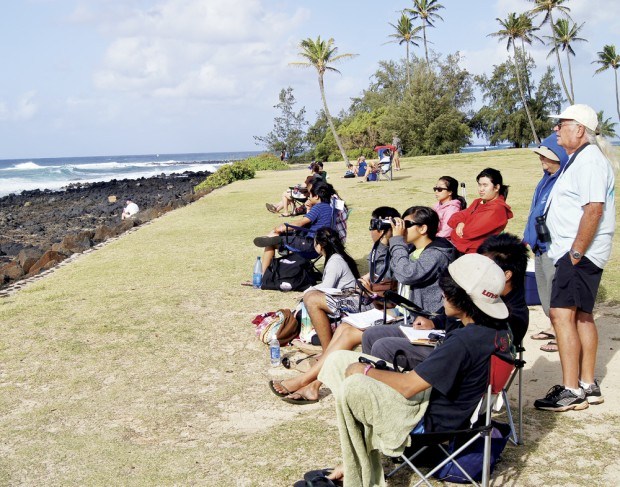PO‘IPU — Following two good months of counts, the Hawaiian Islands Humpback Whale National Marine Sanctuary Ocean Count on Saturday yielded just one whale on average per 15-minute count period. The Kaua‘i count compared with the rest of the state,
PO‘IPU — Following two good months of counts, the Hawaiian Islands Humpback Whale National Marine Sanctuary Ocean Count on Saturday yielded just one whale on average per 15-minute count period.
The Kaua‘i count compared with the rest of the state, with the Big Island and O‘ahu also reporting sightings of just one whale on average during a 15-minute count period during the program’s last day.
“It’s not like how you see it on TV,” said Kathy Kawecki of Lake Tahoe, Calif., one of the counters at the Po‘ipu Beach Park site. “There are long periods of waiting before activity can be seen. That is why it’s good to have activity books so the younger children can still learn while waiting.”
Kawecki, a first grade teacher, brought her daughter Skyler, 9, to the beach for the Saturday count. Skyler was engrossed in a whale activity book while everyone else kept their eyes peeled on the ocean.
They were among 106 registered volunteers who manned 14 different count sites on Kaua‘i from the Lumahai Lookout to the Pacific Missile Range Facility in Mana.
Po‘ipu was one of two sites to register less than one whale sighting, its initial sighting coming within the first 30 minutes of the count. But observations of spinner dolphins and the visits by sea turtles kept counters on their toes.
“Today’s event capped off a successful season with more than 2,000 volunteers participating and observing humpback whales displaying a variety of behaviors, as well as other marine wildlife including Hawaiian monk seals, sea turtles, spinner dolphins and numerous sea birds,” said Christine Brammer, sanctuary ocean count project manager. “High winds made viewing challenging along some coastlines around the state.”
The Kilauea Lighthouse was the most productive, yielding five sightings per 15-minute count period, followed by the Lumahai Lookout with three. Crater Hill and Ninini Point reported two sightings in the 15-minute count period.
“This is my 30th count,” Edd Schepker said. “That means we’ve done this for 10 years, and a lot of whale things have happened during that time.”
Naturalist Bruce Parsil’s task was to distribute information to passers-by who were curious about what was taking place.
On Saturday, Jean Souza, the Kaua‘i programs coordinator for the Hawaiian Islands Humpback Whale National Marine Sanctuary, noted 199 people were recipients of whale education at the different sites.
For Saturday’s count on O‘ahu, Kaua‘i and the Big Island, the final tally for the 2012 season, more than 570 volunteers collected data from the shorelines for the annual Hawaiian Islands Humpback Whale National Marine Sanctuary Ocean Count.
The sanctuary, which is jointly managed by the National Oceanic and Atmospheric Administration and the state Department of Land and Natural Resources, protects humpback whales and their habitat in Hawaiian waters where the whales migrate each winter to mate, calve and nurse their young.
Estimates of up to 12,000 humpback whales are found in Hawaiian waters each year, and the findings of the annual Ocean Count are used to corroborate these findings.
Visit www.hawaiihumpbackwhale.noaa.gov for more information.


